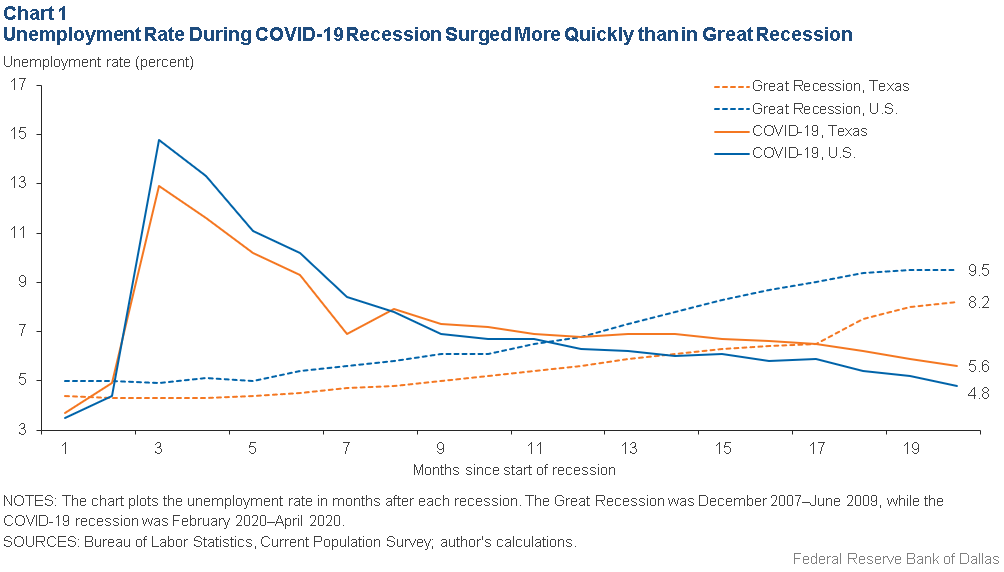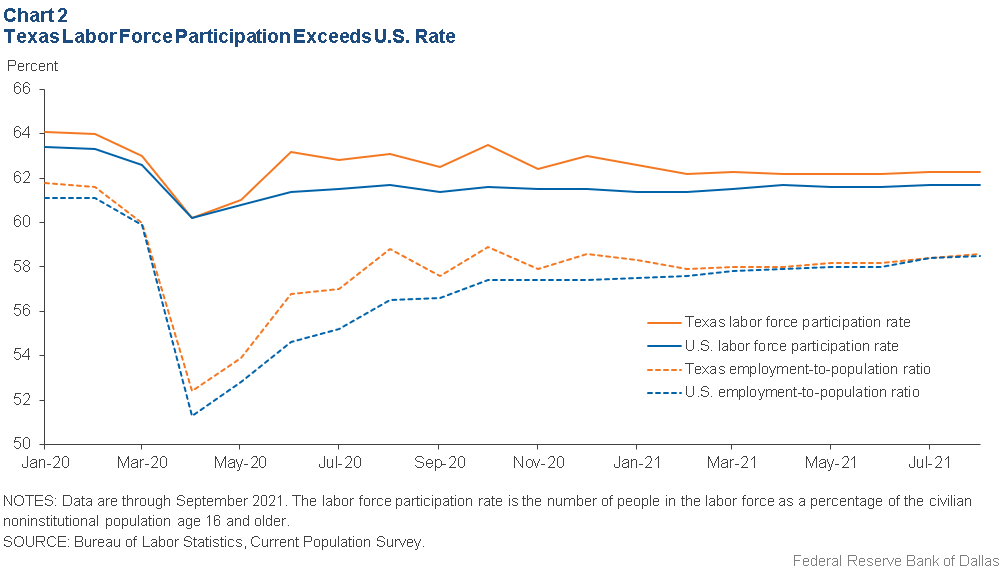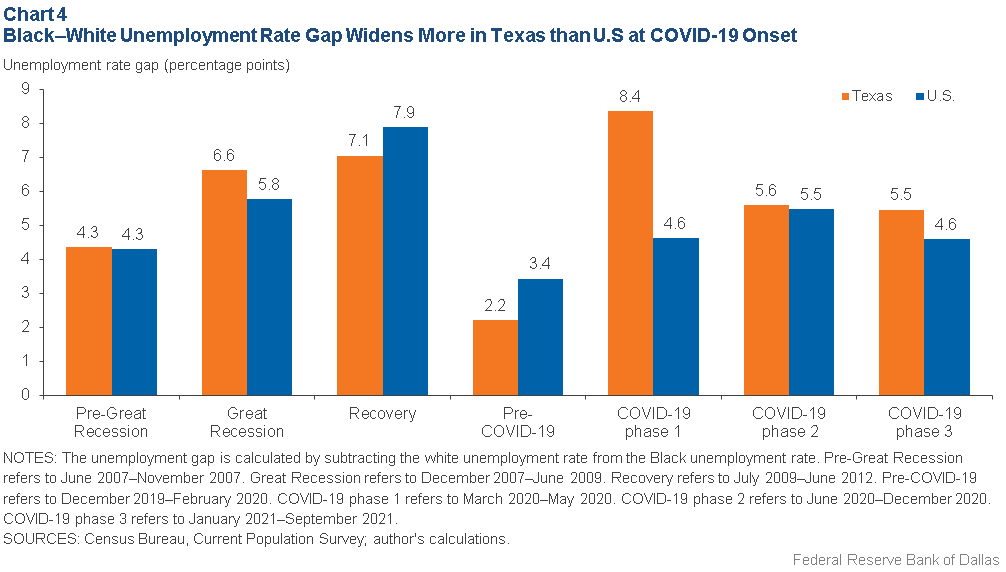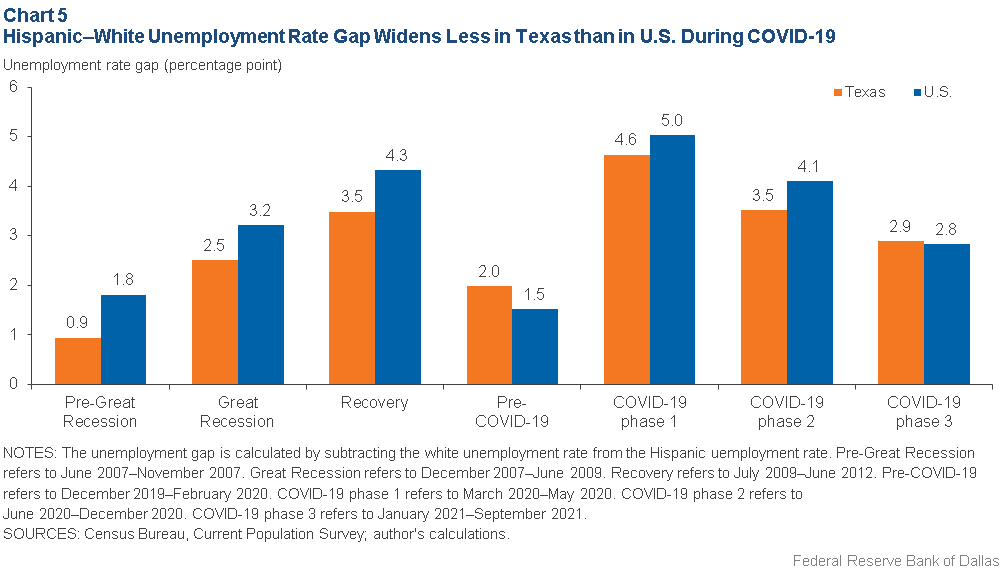
Texas joblessness persists above U.S. rate, weighing on black, Hispanic workers
In April 2020, the U.S. unemployment rate surged to a postwar-record 14.7 percent, a side effect of the arrival of COVID-19 and the lockdowns and shelter-in-place orders accompanying it.
Joblessness began receding two months later as restrictions eased and mobility improved, though the pace of progress then slowed markedly. The pandemic’s endurance and its economic impact were largely to blame (Chart 1). More than a year later, in September 2021, the U.S. unemployment rate was 4.8 percent—1.3 percentage points above the prepandemic rate in February 2020.

In Texas, the unemployment rate also declined but has remained persistently higher than in the U.S. at 5.6 percent in September. The COVID-19 impact was later to arrive in the state, where unemployment topped out at 12.9 percent and has exceeded the U.S. rate since August 2020. Underlying Texas’ weaker performance are demographic-based unemployment disparities, particularly affecting Black and Hispanic workers. The differences in Black and white unemployment rates and Hispanic and white rates remain well above preCOVID-19 levels.
The Texas–U.S. unemployment rate differential during the COVID-19 downturn has followed a very different pattern than during the 2007–09 Great Recession, when Texas’ rate remained well below that of the nation. Indeed, a strong Texas economy and typically higher job growth than the nation meant that the state’s jobless rate consistently trailed the nation’s until the 2015 oil bust.
The subsequent emergence during the pandemic of a persistent gap—Texas unemployment exceeding the U.S. rate—appears to suggest that COVID-19 has taken a greater toll on the state labor market. This runs counter to other data that point to a less-severe economic downturn in Texas. For example, payroll employment data indicate that Texas proportionately lost fewer jobs in the pandemic than the nation overall. As of September 2021, Texas payroll employment was 1.7 percent below pre-COVID-19 employment, while the U.S. was 3.3 percent short.
A host of explanations could account for Texas’ relatively higher unemployment rate—among them, the state’s higher labor force participation rate, policies that encouraged Texans to go back to work sooner, and COVID19-driven changes in the way the official jobless rate is calculated.
Seeking Work in Texas
A simple, albeit mechanical, reason for the elevated Texas unemployment rate could be that a greater proportion of people are looking for work. The state’s labor force participation rate exceeded the nation’s during the recovery from COVID-19, even though their employment-to-population ratios are similar (Chart 2).

The two measures affect the unemployment rate in opposite ways. More workers looking for jobs adds to unemployment, while a higher employment-to-population ratio reduces the ranks of the unemployed. Thus, the change in the unemployment rate roughly equals the change in the labor force participation rate less the change in the employment-to-population ratio.
The higher labor force participation rate in Texas suggests that the state has a relatively larger pool of workers available to fill job openings, helping firms here to somewhat better navigate pandemic-era labor shortages than businesses nationally. Nonetheless, the labor force participation rate and employment-to-population ratio remain well below prepandemic levels, signaling that the labor market remains a long way from healing completely.
Additional Factors
Other factors may be contributing to the unemployment rate differential between Texas and the U.S. Business closures and social-distancing policies mandated by state and local governments differed widely across states. Earlier resumption of work search requirements to maintain eligibility for pandemic unemployment benefits in Texas may have kept more state residents in the labor force looking for jobs relative to states without such mandates.
While the initial surge in COVID-19 cases and deaths in Texas was less pronounced, per capita cases and deaths in Texas exceeded the national average by summer 2020, likely slowing improvement in the state unemployment rate. The persistence of the higher unemployment rate in Texas is puzzling because subsequent waves of COVID-19 similarly affected the state and nation.
There could be another technical explanation for some of the gap between Texas and the U.S. It could be an artifact of significant changes to the model-based estimation method for producing reliable state-level unemployment rates and to seasonal smoothing adjustments that the Bureau of Labor Statistics (BLS) implemented in response to sharp swings in labor force numbers after the initial COVID-19 outbreak. If such a measurement issue is the cause, some of the gap may disappear once annual revisions to civilian labor force estimates are made before the release of January 2022 data.
Notably, the unemployment rates calculated from household responses in Current Population Survey data and seasonally adjusted using a simpler procedure reveal that, while the gap between Texas and the nation fluctuated after August 2020, it has not been nearly as persistent as the gap in the official BLS rate. In fact, these simpler calculations suggest that the unemployment rate in Texas has been lower than in the U.S. in recent months.
Demographic Differences
Demographic differences could also account for a portion of the gap. Texas exceeds the U.S. in the share of Hispanics, younger workers and those without a college degree. These groups were disproportionately affected by COVID-19.
Comparing changes in average unemployment rates in the months before COVID-19 (December 2019 to February 2020) to the period after the initial outbreak (March 2020 to September 2021), most demographic groups in Texas experienced a smaller jobless rise than their counterparts nationally (Chart 3).[1]

However, larger unemployment increases among Black workers and those without a high school education in Texas stand out and suggest that the pandemic took a greater toll on the labor market prospects of some vulnerable groups. On a positive note, the gender gap in the unemployment rate, which inched up nationally, actually contracted in Texas.
Evolving Gender Gap
More disaggregated data, however, suggest a broader gender gap in the initial phase of the pandemic and significant heterogeneity during subsequent phases of COVID-19.[2] The gender gap in Texas widened from 0.8 percentage points just before the pandemic (the female unemployment rate exceeded the male rate) to a whopping 1.4 percentage points in the first phase of COVID-19 (March to May 2020). At the national level, there was an even bigger increase, to 1.7 percentage points.
The gender gap in the state narrowed sharply in phase 2 of the pandemic (June 2020 to December 2020) and reversed in phase 3 (January 2021 to September 2021), with the female unemployment rate improving to an average rate of 5.7 percent so far in 2021—lower than the 6.3 percent rate for men in Texas.
Labor demand factors, such as differences between men and women in the occupations and industries in which they work, led to the sharp rise in the unemployment-rate gap in the initial phase of the pandemic, recent research on the impact of COVID-19 has shown.[3]
Texas’ slightly smaller rise in the unemployment gender gap partly reflects that relatively more women work in industries such as professional and business services, and financial activities—among industries with the lowest unemployment rates immediately after the pandemic’s onset.
Black–White Jobless Gap
Pandemic-era changes in the unemployment rate have been uneven across racial groups whose labor market prospects are known to be highly sensitive to economic downturns (Chart 4).

After widening during the Great Recession, the Black–white unemployment-rate gap had narrowed to 2.2 percentage points in Texas just before the arrival of COVID-19—somewhat lower than the 3.4 percentage points for the nation. But the gap in Texas nearly quadrupled to 8.4 percentage points, the unemployment rate breaching postwar records as the pandemic unfolded. Compared with Texas, the increase in the gap for the nation was relatively modest.
The Black–white unemployment-rate gap in Texas is cyclically more sensitive than in the nation and has remained stubbornly elevated. It continues to exceed pre-COVID-19 levels even in later phases of the pandemic.
Hispanic Gap in Texas
The Hispanic–white unemployment gap is not as pronounced as that for Black workers in both Texas and the U.S.[4] One reason is a larger prevalence of undocumented Hispanic immigrants who do not qualify for jobless benefits. Thus, generous unemployment benefits, which can damp job search efforts and contribute to higher unemployment, were less of a factor in pushing up the Hispanic unemployment rate.
During the initial phase of the pandemic, the Hispanic–white gap exceeded the Black–white gap nationally but not in Texas (Chart 5). The outsized impact for Hispanics nationally as the pandemic began is attributable to their greater employment concentration relative to white workers in especially impacted industries and occupations.
In Texas, the Hispanic–white gap initially remained well below the national gap because relatively fewer Hispanics were employed in the hard-hit leisure and hospitality sector—10.9 percent in Texas versus 12.6 percent nationally. Hispanics also have a larger presence in the state’s financial activities sector, which was among those with an especially low unemployment rate following COVID-19’s onset.

Persistent Inequities
Charts 4 and 5 show that, unlike the gender gap situation, racial differences in unemployment are more persistent. Each additional spell of joblessness affecting long-term labor market prospects feeds into more persistent wage and income gaps.
Racial minorities—in particular, those who are Black and Hispanic—generally face greater financial hardship relative to those who are white even during periods of relative economic prosperity. Just 14 percent of Black families and 10 percent of Hispanic families had enough liquid savings to cover six months of household expenses in case of a potential job loss, compared with 36 percent of white families, according to a recent study based on 2016 data from the Survey of Consumer Finances.[5]
Such stark differences in liquid savings have long existed alongside a persistent wealth gap between white and Black/Hispanic households. Median household wealth was $24,100 for Black families and $36,200 for Hispanic families in 2019, significantly less than the $188,200 for white families, according to a Federal Reserve Board report.[6]
Higher rates of joblessness for minorities during economic downturns can compound such financial disparities. A renewed public policy focus to reduce the unemployment-rate gap could be beneficial because most of the economic and fiscal stimulus programs that supported vulnerable Americans during the COVID-19 economic crisis have ended even as Black and Hispanic households still face considerable financial challenges absent rapidly improving labor market prospects.
What’s Behind the Gap?
The occupational distribution of employment for Black and Hispanic workers is the most important factor affecting racial disparity in pandemic unemployment rates in the U.S. and Texas.[7] There’s a greater prevalence of Black and Hispanic workers in low-skill jobs, typically the most vulnerable positions.
At the same time, minorities had more limited access to remote-compatible jobs and worse health outcomes from COVID-19. Even after accounting for these factors, a substantial part of the Black–white and Hispanic–white wage gap remains unexplained. Discrimination may also play a role.
A larger increase in the Black–white unemployment-rate gap due to COVID-19 in Texas is difficult to reconcile with differences in industry/occupational distribution or educational attainment of Black workers in Texas vis-à-vis the U.S. In Texas, Black workers are less likely to be employed in industries hard hit by COVID-19’s impact and have higher educational attainment than in other states on average.
For example, a relatively smaller share of Black workers in Texas were employed in the three major sectors with the highest COVID-19-related unemployment rates—leisure and hospitality, other services, and wholesale and retail trade.
Other employment characteristics—notably, fewer Black workers in essential services or remote-compatible jobs and a greater number in high-contact industries in Texas—could explain the sharper rise in unemployment rates, though state-level data on these job attributes by demographic segment are scarce.
There are, however, signs that the Black–white unemployment-rate gap in Texas has narrowed considerably. In the most recent three months ended in September, the gap was smaller in the state than in the U.S.—an indicator of improvement amid ongoing job growth here.
Notes
- The gap between Texas and the U.S. in the pre- versus post-COVID-19 average unemployment rates calculated directly from Current Population Survey data differs from the gap in averages based on the official unemployment rate.
- To avoid month-to-month volatility in the Texas unemployment rate for different demographic groups, the rates are averaged over multiple months.
- “Effects of the COVID-19 Recession on the U.S. Labor Market: Occupation, Family, and Gender,” by Stefania Albanesi and Jiyeon Kim, Journal of Economic Perspectives, vol. 35, no. 3, 2021, pp. 3–24.
- “How Foreign- and U.S.-Born Latinos Fare During Recessions and Recoveries,” by Pia Orrenius and Madeline Zavodny, The Annals of the American Academy of Political and Social Science, vol. 695, no. 1, 2021, pp. 192–206.
- “Disparities in Wealth by Race and Ethnicity in the 2019 Survey of Consumer Finances,” by Neil Bhutta et al, FEDS Notes, Sept. 28, 2020.
- “Changes in U.S. Family Finances from 2016 to 2019: Evidence from the Survey of Consumer Finances,” by Neil Bhutta et al., Federal Reserve Bulletin, vol. 106, no. 5.
- “Early Evidence of the Impacts of COVID-19 on Minority Unemployment,” by Kenneth A. Couch, Robert W. Fairlie and Huanan Xu, Journal of Public Economics, vol. 192, no. 104287, 2020.
About the Author
Anil Kumar
Kumar is an economic policy advisor and senior economist in the Research Department at the Federal Reserve Bank of Dallas.
Southwest Economy is published quarterly by the Federal Reserve Bank of Dallas. The views expressed are those of the authors and should not be attributed to the Federal Reserve Bank of Dallas or the Federal Reserve System.
Articles may be reprinted on the condition that the source is credited to the Federal Reserve Bank of Dallas.
Full publication is available online: www.dallasfed.org/research/swe/2021/swe2104.
